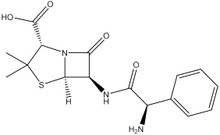 Loading... Please wait...
Loading... Please wait...Categories
Ampicillin Sodium Salt
(Ampicillin Sodium Salt; ampicillin sodium; amblosin; plumericin; viacilina-A)
Purity >98.0%
Molecular Biology Grade, Cell Cuture Tested
| CAS Number: |
69-52-3
|
| Chemical Formula: |
NaC16H18N3O4S
|
| Molecular Weight: |
371.4 g/mol
|
Ampicillin is an inhibitor of bacterial cell wall synthesis that acts by disrupting the crosslinking of peptidoglycan. Specifically, ampicillin functions by binding and in turn deactiviting transpeptidases. High activity against gram negative bacteria.
Often used to select for a desired gene (plasmid) by bacteria such as E. coli. A common example, is selecting against the plasmid encoding for β-Lactamase production such as pBR322 or pUC (Ampr). Amplicillin soluble in water and should be stored between 2-8 °C.
Free Shipping in the Continental USA
Preparation of 100 μg/mL Ampicillin Stock Solution
For 1x stock solution, use 100 μg/mL. For 1000x stock solution, use 100 dissolved in water. However, 70% ethanol can be added to the solution so that the Ampicillin solution does not freeze at 20 °C.
Note: Do not use 100% ethanol; the Ampicillin will not dissolve.
Preparation of LB liquid media or Agar Plates with Ampicillin
This protocol will yeild a final concentration of 50 μg/ml of Ampicillin
| Reagent: |
Amount:
|
| Tryptone |
10 g
|
| Yeast Extract |
5 g
|
| NaCl |
10 g
|
| dH2O |
1 L
|
| Agar (plates only) |
15 g
|
| Ampicillin |
0.05 g
|
- Dissolve 10 g of tryptone, 5 g of yeast extract, 10 g of NaCl, and 15 g of Agar (if preparing agar plates) in 1L of molecular biology grade H2O.
- Aliquot media into several flasks and cover with a lose caps be sure not to fill flasks more than ¾ full.
- Autoclave 20-30 minutes, allow media to cool to ~50 °C. It is important to allow the media to cool since ampicillin is degraded at high temperatures.
- Addition of antibiotic and storage of LB media
a. Liquid Media: Tighten cap and store at room temperature until use, add 0.050 g of ampicillin until dissolved. Pour plates in a laminar-flow hood. Store at 4 °C in the dark, inverted, up to 3 months.
*If bubbles are present in plates a flame from a Bunsen burner can be briefly passed over the plates. Be sure to keep flame moving while removing bubbles, too much heat can destroy the Ampicillin. 1 L of LB media will make ~30 plates, if you are looking to save some time then our selection of premade E. coli plates maybe of interest.
b. Agar Plates: Add 0.050 g of Ampicillin and stir
Protocol for the Selection of Ampicillin Resistant Bacteria
View this method on protocols.io and use it directly at your bench
Comparable Items:
| Akron Biotechnology | AK0839-0010 |
| Akron Biotechnology | AK0839-0025 |
| Akron Biotechnology | AK0839-0100 |
| Acros Organics | 61177-0050 |
| Acros Organics | 61177-0250 |
| Alfa Aesar | J63807-06 |
| Alfa Aesar | J63807-03 |
| Alfa Aesar | J63807-09 |
| Amresco | E477-20ML |
| Amresco | 0339-25G |
| Amresco | 0339-100G |
| Biotix | 2040 |
| EMD Millipore | 171254-25GM |
| EMD Millipore | 171254-5GM |
| EMD Millipore | 171255-20ML |
| Grow Cells | MBPC-1900 |
| Grow Cells | MBPC-1901 |
| Indofine | A010410GM |
| US Pharmacopeia | 1033203 |
Celebrity Endorsements
The most common selectable marker is ampicillin resistance, conferred by expression of beta-lactamase. However, we have found plasmid selection with ampicillin, which is readily hydrolyzed by b-lactamase and inactivated at low pH, to be very weak. Instead, we prefer markers such as tetracycline, chloramphenicol, or kanamycin resistance that are more stable, even in saturated cultures. Indeed, plasmid stability tests should be carried out when expression is low, especially when ampicillin resistance markers are employed. We offer these alternative antibiotics as well.
References Using this Product:
Fenster, K.M.; et al. (2003). Intracellular Esterase from Lactobacillus casei LILA; Nucleotide Sequencing, Purification, and Characterization. Journal of Dairy Science, 89, 1118.

